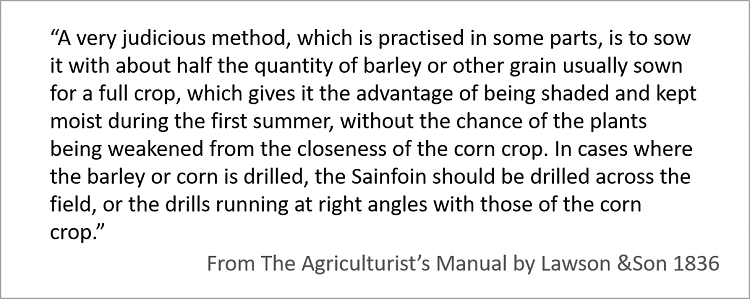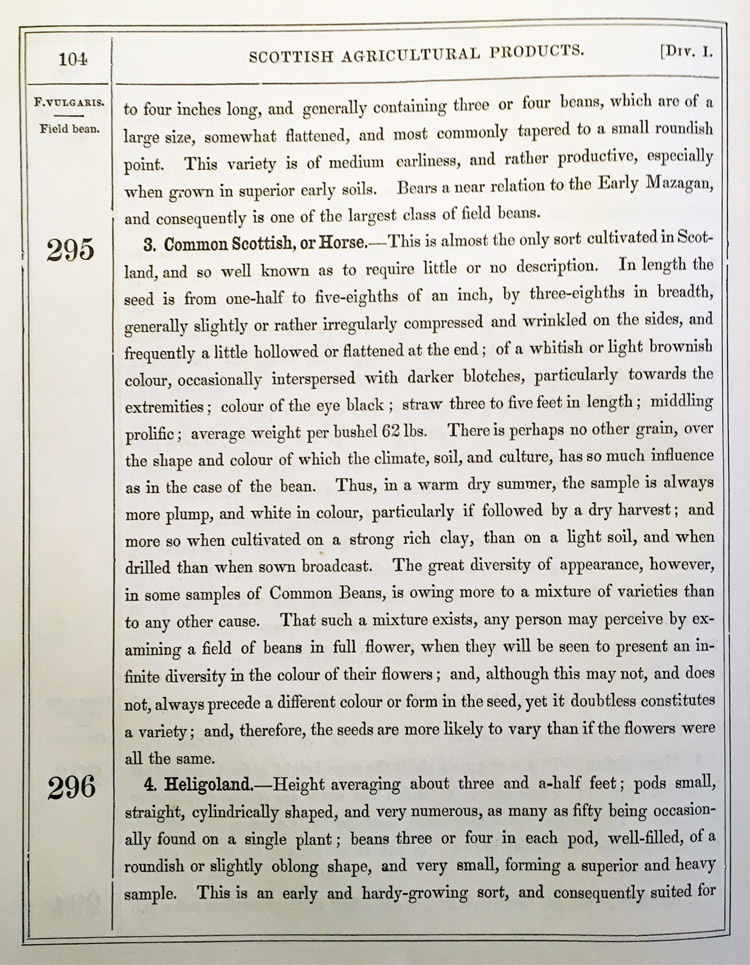The 1800s, especially the first three quarters of it, was a period of notable invention and experiment, building on the gains from the first phase of Improvement that began a century earlier. Mixtures of crops, of grass and of crops and grass together are repeatedly referenced in the various books and manuals published throughout the period.
Several of these mixtures are examined here, as possible pointers and templates for modern attempts to re-diversify agriculture. The main sources are those published by the Lawsons, seed merchants based in Edinburgh, notably their Agrostographia [1, 2], which appeared in various forms from 1833 to 1877. For example –
- barley-sainfoin (cereal-legume) mixture, the barley sown as a ‘nurse’, sainfoin drilled at right angles to the barley (a line intercrop?)
- barley-oat-weld, the first two harvested after the first season, the weld yielding the next year.
- within-species field bean varietal mixtures.
- legume-legume, for example, field bean and vetch/tare.
- barley, oat or any corn sown with grass as a nurse to protect the more valuable grass-legume sward.
As in other articles on this web site about our cool-climate mixtures, all crops were sown as seed mixes rather than line or row intercrops (with the possible exception of barley-sainfoin).
Barley-sainfoin gridded at drilling
When considering which dicot forages to recommend, Agrostographia suggested that sainfoin Onobrychis sativa could be grown in several parts of Scotland, though it was primarily grown in more southern climates. It likes a ‘dry’ and well drained soil, and was also recommended as an addition to their perennial pasture mix on calcareous soil.

As a sole forage, it sometimes suffered in the first year. Therefore to aid establishment, the Lawsons pointed out the practice of sowing a nurse crop, such as barley, first. Then in those situations where that crop was drilled, the sanfoin was drilled at right angles to it, in effect forming a grid, rows of sainfoin crossing rows of barley. The barley was harvested in the first year, as cereal grain or forage crop, leaving the sainfoin to over-winter as a small plant, then extend and flower the next year. It would have been cut one or more times in the summer of the second year, after which it became a perennial forage.

This practice presumably prevented the second drilling (that of the sainfoin) from interfering too much with the first. It might have created an interesting pattern if the drills were reasonably wide apart.

Unlike many mixed crops, the aim of this one was to encourage the legume to establish. Barley would have been sown at a smaller seed weight per acre than when sown for a sole crop, so as to form enough cover to protect the sainfoin without completely denying it light and nutrients. It is unclear whether any particular advantage came to the barley, since it would grow much faster than sainfoin in the first year. No information is available from that time on nodulation in the legume and whether it released any fixed nitrogen when the barley needed it. In recent experience, sainfoin grows luxuriantly at 58N, withstanding the mild maritime winters without any obvious setback [4].
Field bean variety mixtures
In their Agriculturists’ Manual (1836) and the later Synopsis (1852), the Lawsons’ list varieties of Vicia faba of which the main one grown at that time was named Common Scottish or Horse Bean. They write: “Beans enter the rotation of cropping in the early districts of Scotland, and are very successfully cultivated on all strong soils, forming an excellent preparation for wheat. The straw or haulm forms nutritious food for horses during the winter and spring months.”
This comment – on the successful cultivation of beans – contrasts with the decline in area of this crop, along with many other arable crops, during the economic depression after 1880 when agriculture made one of its shifts to grass, on this occasion because of low global grain prices.

The point of interest here is the comment of what appear to be crop variety mixtures, identified by the range of flower colour. The wording in the above is little different from that given in the earlier 1836 Agriculturist’s Manual, and extract of which is given below.

The authors could not be certain that the fields they referred to were intentionally sown mixtures. Many of them would have been landraces, maintained by farm-saved seed, or seed impurities or even ‘volunteers’ (which arise from seeds shed by a previous crop and emerging in the current crop). Certainly, faba bean today readily gives rise to short-lived volunteer populations on waysides and in fields of other broadleaf crops..

This note from the Lawsons’ experience shows that despite the seedsman’s quest for purity in seed stocks, diversity was hard to eradicate.
Barley-oat-weld – grain and dyestuff
The plant weld Reseda luteola was once cultivated widely for the yellow dye that can be extracted from its leaves, stems and flowers. Weld as a commercial product has been replaced by imported dyestuffs, but it remains a common wild plant, sometimes growing by roads and especially on wasteland and old industrial sites.
As a crop, it was typically sown in spring along with a corn, such as oats or barley. When they were harvested in autumn, the weld was left to overwinter, then harvested the next year. The plants “are pulled when in flower, or before the seed is fully ripe, and used either in a green or dry state” [3]. Thirsk [5], writing about weld cultivation in 1600s England, relates a similar sequence: barley or oats sown (sometimes buckwheat), weld harrowed in, the corn harvested in autumn and the weld “pulled up by the roots, dried and stored the next year”; and then an usual variation in Kent, weld undersown in barley, the field used for grazing in autumn and the weld again harvested the next summer.
The diagram shows barley and oat grown as a corn mixture, weld seedlings growing beneath them in the first year then weld plants flowering among the corn stubble the next summer [4].

Two legumes: field bean and common vetch
Agrostographia also describes an unusual mixture – the bean Vicia faba and a forage legume, common vetch Vicia sativa (also known as common tare). Common vetch, as were many other vetches and tares from the genus Vicia, was grown as a commercial fodder crop. Its cultivated forms were reported to be different from the smaller and more slender local wild form. The Synopsis [3] distinguishes the common or summer variety from the winter variety, and also the Hopetoun Tare, which appears to be a landrace selected from a field of the summer variety.
Common vetch was grown as a green fodder and also for seed. Agrostographia describes two types of crop mixture. In one, the vetch is sown with cereals. Agrostographia writes: “The practice of sowing one or other of the cereal grasses (oats or barley) among Tares is strongly recommended, not only as it ensures a greater bulk of produce from the stems of the grains rising above the Tares, but they also serve to prevent them lying on the ground, and so becoming injured in damp weather; cattle are also fonder of the fodder in a mixed than in an mixed state.” It appears from this statement that the mixed crop has at least three advantages: more grain from the cereals, support to keep the vetch off the soil and a more nutritious (balanced) fodder.
In the other mixture, vetch is grown with field bean. Two legumes – but the benefit of sowing them a mixture is unclear. Agrostographia: “When sown for their ripe seed, the Summer Tare is generally mixed with beans, or peas and beans, in the proportion of about a fourth part in bulk, or less …”. In contrast, the winter vetch, sown in autumn for seeds, was said to be generally sown alone, but the manual advises they should be sown with winter bean – “… the seeds being easily separated from the beans, when thrashed, by means of a proper sized riddle”. The beans must have given the vetch support as did the cereal crop in the other type of mixture, but what benefit came to the beans?
Corn as a nurse for grass
The main type of mixture described in Agrostographia was that of ‘grass’ comprising grasses, legumes and other dicot (broadeaf) plants. These highly diverse seed mixtures were generally more valuable and more costly to establish than crop mixes, but also more open to damage in the weeks and months after they were sown. To help grass mixtures to establish, they were sown with a corn crop, oats or barley, which was harvested or grazed after it had done its job of nursing the grass seedlings.
More on grass mixtures and corn nurses is given at Grass mix diversity a century past. Further articles on this theme are in preparation.
.
Sources, references, links
[1] Agrostographia; a treatise on the cultivated grasses and other herbage and forage plants. Authors: The Lawson Seed and Nursery Company. Successors to Peter Lawson and Son. Date: 1877 (6th Edition, by David Syme, Manager). Publisher: William Blackwood & Sons, Edinburgh and London. Online through sources such as the Biodiversity Heritage Library. Information in the Agrostographia was first published in 1833, though not under that name, and then as part of The Agriculturist’s Manual in 1836 [3].
[2} Agrostographia as a title is of much older origin, being that of a major compendium on grasses written in Latin, by or edited by, Johannes Scheuchzer (1684-1738), published 1719, edition of 1775 viewed. Scheuchzer is credited with being a founder of the science of Agrostology – the study of grasses.
[3] The Lawsons’ Agriculturist’s Manual (1836) and Synopsis (1852), the latter an expanded version of the Manual, are invaluable sources for 1800s crops and their varieties, both available online, e.g. through the Biodiversity Heritage Library. Details:
The Agriculturist’s Manual. Peter Lawson and Son 1836. Edinburgh, London and Dublin. Being a familiar description of the Agricultural Plants Cultivated in Europe including practical observations respecting those suited to the Climate of Great Britain; and forming A Report of Lawson’s Agricultural Museum in Edinburgh (Seedsmen and Nurserymen to the Highland and Agricultural Society of Scotland).
Synopsis of the vegetable products of Scotland. Peter Lawson and Son. 1852. Private Press of Peter Lawson and Son. Prepared for the Great Exhibition and dedicated to William Jackson Hooker, Director of the Royal Botanic Gardens of Kew.
[4] Sainfoin was grown in the Living Field garden at the James Hutton Institute, Dundee, for several years. It grew slowly in the first year but overwintered successfully and then flowered in the second and subsequent years. Weld grows easily at the Living Field, either flowering the same year as sowing or overwintering and flowering the next year. A mixture of oat, barley and weld was sown on one occasion but the weld failed!
[5] Thirsk J. 1997. Alternative agriculture: a history – from the Black Death to the Present Day. Oxford University Press.

Non-serious depiction of a barley-sainfoin mixture to show the practice of drilling barley in one direction then drilling sainfoin at right angles. Described in Agrostographia 1877. Images from plants grown in the Living Field Garden, Dundee.
